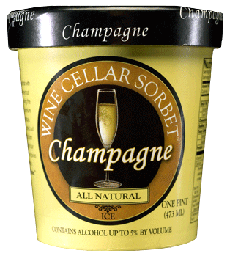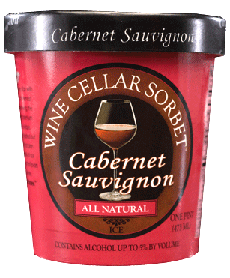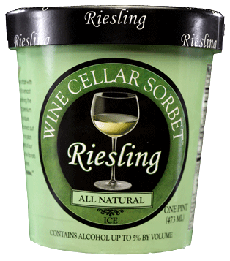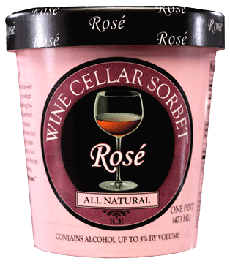 |

| |

Sorbets made from vintage wines are truly special. Shown from top to bottom: Champagne, Rosé and Pinot Noir Wine Cellar Sorbets. In the background is the Brooklyn Bridge, leading to the home of Wine Cellar Sorbets.
|
| WHAT IT IS: The first-ever U.S. line of wine sorbets, made with Cabernet Sauvignon, Champagne, Pinot Noir, Riesling, Rosé and Sangria. |
| WHY IT’S DIFFERENT: The ethereal quality of sorbet is further elevated with the accent of wine. If you like both sorbet and wine- or liqueur-accented foods, put them together and you get heaven. |
| WHY WE LOVE IT: We used to spend lots of time making our own sorbets from grappa and other distillates—always a crowd-pleaser. Now, Wine Cellar Sorbets does the heavy lifting, and everyone is still thrilled with the end result. |
| WHERE TO BUY IT: WineCellarSorbets.com, and retailers listed on the website. |
|
|
 |

Wine Cellar Sorbets:
“Vintage” Desserts
Last year, we became addicted to Wine Cellar Sorbets, elegant sorbets made with vintage wines. In fact, they’re made with so much wine that one must be of legal drinking age and show an I.D. in order to purchase them. We were so excited by the red and white wine sorbets that we called all of our wine collector buddies and told them to run, not walk, to buy all six flavors.
At that time, the wine sorbet was only available in metropolitan New York. Now, as the company builds its national distribution, fans can shop online. We encourage you to indulge in a little luxury and place your order! If you have influence with your local specialty food store, have the line brought in so that you (and all of your food-loving friends) can have a steady supply.
More than a dessert sorbet, wine sorbets can be used as “palate cleansers,” served between the fish and meat courses or after a spicy or strong-flavored course. Instead of a glass of wine on the patio on a hot summer day, a goblet of wine sorbet hits the spot. The sorbets can be used in a variety of cocktails and to enhance fruit dishes, but we don’t wait for a special occasion: Our evening treat is to have a few spoonfuls. It’s rapture in a pint. Read more about sorbet bliss in the full review below.
- Read reviews of more of our favorite ice creams and sorbets in THE NIBBLE online magazine.
- See the Table of Contents of the July issue of THE NIBBLE, plus the prior issues archive and our most popular articles.
- All of the Top Pick Of The Week newsletters are permanently archived on TheNibble.com, in chronological order and by product category.
|
THE NIBBLE does not sell the foods we review
or receive fees from manufacturers for recommending them.
Our recommendations are based purely on our opinion, after tasting thousands of products each year, that they represent the best in their respective categories. |
Make Your Own Sorbet
 |
 |
 |
| The Ultimate Frozen Dessert Book, by Bruce Weinstein and Mark Scarbrough. There’s way more to frozen desserts than just ice cream sandwiches! Frozen cakes, semi-freddos and gelatos are among the many recipes you’ll find in this comprehensive cookbook. Click here for more information or to purchase. |
The Ultimate Ice Cream Book, by Bruce Weinstein. With delicious recipes for more than 500 ice creams, sorbets and granitas, you and your ice cream machine will be busy for several years—and your popularity quotient will soar. Click here for more information—and let us know what your favorite flavors are. |
Williams-Sonoma Frozen Desserts, by Melanie Barnard. This book acts as a mini cooking course, guiding you through the world of frozen desserts from start to finish. Work your way up from a simple ice cream all the way to an elegant torte. Click here for more information or to purchase. |
Wine Cellar Sorbets: “Vintage” Desserts
INDEX OF REVIEW
|
MORE TO DISCOVER
|
Wine Cellar Sorbets have become our new BFFF (best food friend forever)—to the extent that a person and a food company can be pals. We love sorbet, we love alcohol-based sorbets, and they’ve developed the first-ever line of wine sorbets. These precious pints are perfect as palate-cleansers, desserts and snacks (they make one heck of a Slushee). Vintage wines are frozen into sorbets, with just the tiniest amount of sugar plus a stabilizer and pectin for consistency. Now, you can toast with Champagne sorbet...and if you’re the designated driver, you can indulge in Cabernet Sauvignon sorbet or Pinot Noir sorbet without getting snockered (the alcohol volume is no more than 5%,* as opposed to 12% or greater for wine). We love Wine Cellar Sorbets as an everyday treat and we love to impress guests with it. We’re thrilled that we no longer have to make our own alcohol-based sorbets. We are happy campers at Camp WCS.
*Most beers are about 5% alcohol by volume, but although you may easily drink a couple of beer, your lips will freeze if you try to eat a whole pint of sorbet.
We have been feasting on these sorbets for about a year now, but since distribution was limited to the Metropolitan New York area, we couldn’t elevate Wine Cellar Sorbets to Top Pick Of The Week status. Now, with new online ordering capability, no one need be deprived. (The young company continues to expand its retail distribution.)
What’s That About Palate Cleansers?
For elaborate dinner parties, we like to make a sorbet or granita as a palate cleanser. A small dish of sorbet has traditionally been used as a palate cleanser in French and continental cuisines (you may have seen it referred to on menus as an intermezzo), to refresh the taste buds between the fish course and the meat course. At the simplest, it’s a lemon sorbet that clears the palate from any lingering fish flavors, so the next course can be fully experienced. There’s a similar practice in the serving of sushi and sashimi: Slices of pickled ginger are provided so that each type of fish can be appreciated without flavor carryover from the prior piece.
Over the years, creative chefs have added herbs and other flourishes (edible flowers, liqueur) to the intermezzo sorbet. Palate cleansers should not be particularly sweet—raspberry sorbet would never do, for example—because the next course is savory. One of the greatest palate cleansers we experienced was at a two-star restaurant on the French Riviera. It was a savory granita made with fresh herbes de Provence—thyme, rosemary, basil and marjoram probably plucked that morning from the restaurant’s herb garden. There was no noticeable sweetness, just the amazing flavor of a fresh herb ice—and a memory that will endure a lifetime.
The palate cleanser is a nicety rather than a necessity. No fine meal has ever been impaired by the lack of one. Palates can be cleansed with bread and water (in the case of too much hot chile pepper, only time will help–and some soothing sour cream). But just as some sushi aficionados have grown to love the ginger as much as the sushi itself, fine sorbet is a delight whenever it appears. Wine Cellar Sorbets was created as an all-occasion sorbet, but if it helps bring back the custom of the palate cleanser, that’s another of its contributions to elegant dining in America.
|

Palate cleansers aren’t meant to be a course, just a taste—a few spoonfuls. Serve them in liqueur glasses, shot glasses, anything small and shapely. Photo by Dusan Zidar | CSP. |
At an elegant dinner, the flavoring we prefer in a palate cleanser is alcohol—marc, grappa*, an eau de vie, or now, Wine Cellar Sorbet’s Cabernet Sauvignon or Pinot Noir. It’s sophisticated, unexpected and never fails to delight guests—to the extent that they’d gladly blow off the next course and sit down with large bowls of it. But, it’s just a palate cleanser: one tiny scoop, that’s it! (To avoid mutiny, make sure your next course is really good.)
*French marc (pronounced mar) and Italian grappa are essentially the same product—potent and a somewhat harsh variety of eau de vie distilled from the pomace (grape residue) left over from making brandy.
ICE CREAM, GELATO, SORBET: WHAT’S THE DIFFERENCE?
Sort out the confusion with our Ice Cream Glossary. |
Wine Cellar Sorbet Flavors
Like vintages of wine, flavors of sorbet will sell out. As Wine Cellar Sorbet’s sommelier seeks the best wines for sorbet, flavors may change on a rotating basis. (Our favorite from the first year’s vintage, Sauternes sorbet, has been replaced by Riesling Sorbet, which we like just as much.) The current “vintages” include:
 Three red wine sorbets: a 2005 Cabernet Sauvignon from California, a 2005 Pinot Noir from New York and a non-vintage Sangria from Spain. Three red wine sorbets: a 2005 Cabernet Sauvignon from California, a 2005 Pinot Noir from New York and a non-vintage Sangria from Spain.- Two white wine sorbets: a non-vintage Champagne from California and a 2004 Riesling from New York.
- One blush wine sorbet: a non-vintage Rosé from New York.
Like most sorbets, these are low in sugar and have no fat. Unlike most sorbets, they are not particularly sweet (see the note about the red wine sorbets at the conclusion of the flavor notes, below). That’s why they make excellent palate cleansers between courses, as well as sophisticated desserts. We also serve them with cheese, and more serving suggestions follow.
We found most of the flavors over a two-week period at our local Whole Foods Market. Since the store only gives shelf space to four flavors at a time, we’ll have to keep checking back to update this review.

|
The Red Wine Sorbets
The red wine sorbets are less sweet than the white and blush wine sorbets. If you want a more “serious” palate cleanser, start here.
- Cabernet Sauvignon Sorbet is the least sweet of the sorbets, tasting of dark berry fruits like currant and plum, with spicy notes. As with a wine tasting, you can taste all the varietal characteristics, even when frozen. Website recipe: Blackberry Noir Smoothie.
- Pinot Noir Sorbet offers softer red fruit in a sweeter base. It’s more approachable than the Cabernet, but also less complex. It reminded us of what all frozen drinks should taste like, if only manufacturers left all of that excessive sugar out of the mix. Website recipe: Pinot Noir Julius Smoothie.
|
- Sangria Rojo is a spicy, dry blend of Rioja and Tempranillo imported from Spain, mixed with orange juice. We haven’t tried this one yet, but it sounds refreshing, and a departure from the other two reds. Website recipe: Champagne Float.
The White Wine Sorbets
- Champagne Sorbet, according to the release notes, is “tart on the palate with a dry finish that contains hints of yeast.” We keep missing it at retail. Website recipe: The Champagne Float is obvious, but we’re waiting to find it so we can make the ambitious Napoleon Wine Flight—four layers of chiffon cake alternating with four different sorbets, including Champagne Sorbet.
- Riesling Sorbet seems like a regular sorbet with a hit of wine flavoring. The flavors are more sophisticated than the Rosé Wine (see next entry). Though not necessarily characteristic of the Riesling varietal, the flavors—raisins and stewed fruits—are quite tasty and sure to be crowd pleasers. Website recipe: Riesling Sorbet Stuffed Poached Pear.
|

|

|
The Blush Wine Sorbets
- Rosé Sorbet is a re-naming of one of the original flavors, May Blush Wine—a good idea, since Rosé is a contemporary favorite and May Blush Wine, while popular in Germany, sounds like something from centuries past. This is the most subtle of the sorbet flavors, almost like a grape sorbet enhanced with a bit of wine. Yet, the wine has notes of peaches and raisins and is the most accessible for a general group of diners, where it won’t be perceived of as “too sophisticated” but as different, special and delicious.
|
Website recipe: The website only offers up the Champagne Float, which is delicious. But for variety, we’d like to add our own recipe. We think this sorbet rocks as a parfait with sliced fresh strawberries. You can drizzle a high-quality strawberry syrup, preserve or rose syrup (available at Middle Eastern stores, and not meant as a pun with the rosé) between the layers or over the top.
Some caveats:
These sorbets are fragile. If not well-handled by the retailer or in your own home (e.g., if the sorbets are left to soften and then refrozen), flavor components can migrate—sugary components can sink to the bottom of the pint, leaving the top less sweet. This doesn’t mean that the sorbet isn’t delicious—just that each bite might not be consistent in taste.
Another thing to watch for is that the first spoonful, especially of the reds, may taste exotic or unusual to many people, since one anticipates a sweet sorbet. The reds have sweetness, but are not “sweet.” After consuming the entire dish, however, every tentative taster will be hooked. The white wine sorbets are a more easy transition.
Serving Suggestions
Wine sorbets are versatile products that clamor to be served in a variety of ways. We personally don’t tamper with them, although one might easily be tempted to make cocktails with gin, vodka, cognac, framboise, etc. The beauty of this product is that the manufacturer has done all the work; all you need to do is dish it out and take the compliments.
For starters, think of it as:
- A frozen wine cocktail—just put the sorbet in a wineglass with a straw (wonderful poolside and at barbecues)
- A palate cleanser between courses—fish and meat, spicy or strong-flavored courses, or between cheese and dessert (serve small amounts)
- On top of a fresh fruit cocktail or berries, poached fruit, or with a fruit plate
- With cheese: as you serve fruit and wine with cheese, give each person a shot glass, cognac snifter or other small glass of sorbet, with an espresso spoon (if the sorbet melts, it can be drunk)
- On a dessert plate, with other assorted goodies
- A first dessert course, or an assortment of flavors as the main event
SERVING NOTE: Sorbet with an alcohol content melts faster than regular sorbet. To serve it as frozen as possible, scoop the balls in advance onto a plate, tray or cookie sheet covered with waxed paper, and freeze until ready to serve. |

Photo by Belinda E. Stojanovic | IST. |
Do check out the recipes on the WineCellarsSorbet.com website.
Palate Cleanser Recipes
These recipes have no wine: Two have mint, a refreshing palate cleanser, and one is a very delicate Earl Grey. They can be enjoyed as palate cleansers or desserts.
Grapefruit Mint Sorbet
Grapefruit sorbet is one of our favorite refreshments. Dressing it up with mint makes it more elegant for a party dessert or intermezzo.
Ingredients
- 1½ cups sugar
- 1½ cups water
- 1/3 cup firmly-packed mint leaves (any fresh mint) plus extra for garnish
- 2½ cups fresh-squeezed grapefruit juice, strained to remove the pulp and seeds (4 large grapefruits)*
*You can use store-bought “fresh juice,” but it will taste so much better if it is truly fresh-squeezed.
Directions
- In a small saucepan, combine the sugar and water and bring to a boil, stirring to dissolve the sugar. Remove from the heat and let cool.
- Add the mint leaves to a food processor or blender and purée; add the sugar syrup and mix until thoroughly combined; then blend in the grapefruit juice. (This base can be made up to two days in advance.)
- Chill the mixture in the refrigerator until it is completely cold, about 1 hour, then freeze in an ice cream maker according to the manufacturer’s instructions.
- Garnish with a curl of grapefruit peel. Do not make more than 3 days in advance.
Lime-Mint Sorbet Recipe
This is a variation of the preceding recipe. In addition to serving it as a palate cleanser, the flavor profile makes it a terrific dessert with Mexican, Thai and Vietnamese cuisine.
Ingredients
- 1½ cups sugar
- 1½ cups water
- 1/3 cup firmly-packed mint leaves (any fresh mint)
- 2½ cups fresh lime juice (about 12 limes, more if using key limes)
- Extra lime and/or mint leaves for garnish
Directions
- In a small saucepan, combine the sugar and water and bring to a boil, stirring to dissolve the sugar. Remove from the heat and let cool.
- Add the mint leaves to a food processor or blender and purée; add the sugar syrup and and mix until thoroughly combined; then blend in the lime juice. (This base can be made up to two days in advance.)
- Chill the mixture in the refrigerator until it is completely cold, about 1 hour, then freeze in an ice cream maker according to the manufacturer’s instructions.
- Serve garnished with fresh mint leaves and/or a lime wheel. For a palate cleanser, you can dip the rims of the serving glass in kosher salt or decorative glass-rimmer salt, “margarita style. Serves 4 to 6.
|

Lime-Mint Sorbet. Photo by Dusan Zidar | BSP. |
Earl Grey Tea Sorbet Recipe
This unusual sorbet is a light and delicious palate cleanser. If you have culinary lavender, add some for a more complex flavor.
Ingredients
- 3 cups water
- 2 cups sugar
- 1½ tablespoons loose Earl Grey tea leaves
(you can substitute 2 tea bags—we like Twinings Earl Grey tea)
- ½ teaspoon culinary lavender (optional)
- 1 teaspoon fresh lemon juice
- A dozen white or green tea leaves for garnish
Directions
- Boil the water and add the tea leaves and lavender, and steep for 5 minutes. Strain the tea and buds and return the brewed tea to a saucepan.
- Add the sugar and stir until dissolved, simmering as necessary. Then add the lemon juice.
- Chill the mixture in the refrigerator until it is completely cold, about 1 hour, then freeze in an ice cream maker according to the manufacturer’s instructions.
- Garnish with a tea leaf. Earl Grey leaves themselves are not attractive (black tea leaves are oxidized); loose white tea leaves or green tea leaves make a very attractive garnish and are tasty, too.
As delicious as these recipes are, we, who enjoy a bit of something cold and sweet after dinner every night, will forsake them for in vino [sorbet] veritas.
—Karen Hochman
FORWARD THIS NIBBLE to anyone who likes sorbet and to great cooks who don’t have time to make their own palate cleansers.
WINE CELLAR SORBETS
Cabernet Sauvignon, Champagne, Pinot Noir, Riesling, Rosé, Sangria Rojo
- Individual Pints
(16 Ounces)
$4.99 to $6.99
Purchase online at WineCellarSorbets.com.
Check the store locator on the website for a retail location near you.
Price and flavor availability are verified at publication but are subject to change.
Back to Index |
 |

|
Read more about our favorite
frozen desserts and related products in
THE NIBBLE online magazine.
|
Check Out These Other “Top Pick Of The Week” Frozen Desserts:
|
Do you have friends who would enjoy THE NIBBLE?
Click here to send them an invitation for the Top Pick Of The Week newsletter. |
ABOUT THE NIBBLE. THE NIBBLE™, Great Food Finds™, is an online magazine plus newsletters about specialty foods and the gourmet life. It is the only consumer publication and website that focuses on reviewing the best specialty foods and beverages, in every category. The magazine also covers tabletop items, gourmet housewares, and other areas of interest to people who love fine food. This e-mail from the editors features the Top Food Pick of the Week.
© Copyright 2004-2026 Lifestyle Direct, Inc. All rights
reserved. All information contained herein is subject to change at any time
without notice. All details must be directly confirmed with manufacturers, service
establishments and other third parties. The material in this e-zine may not
be reproduced, distributed, transmitted, cached, or otherwise used, except with
the prior written permission of Lifestyle Direct, Inc.
|
 |
|
 |








 Three red wine sorbets: a 2005 Cabernet Sauvignon from California, a 2005 Pinot Noir from New York and a non-vintage Sangria from Spain.
Three red wine sorbets: a 2005 Cabernet Sauvignon from California, a 2005 Pinot Noir from New York and a non-vintage Sangria from Spain.




